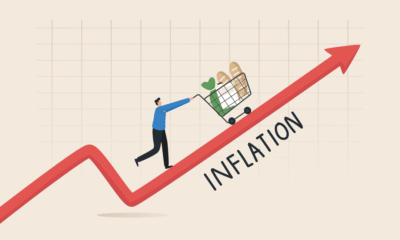Finance
Tech Stocks Lead Market Recovery: Are We Witnessing a New Bull Run?

Introduction to Market Dynamics
The current state of the financial markets exhibits a notable recovery, predominantly driven by a resurgence in the technological sector. As the world continues to navigate through economic challenges, technology stocks have emerged as pivotal players, sparking discussions about the potential onset of a new bull run. This transformation is not merely a fleeting trend; rather, it reflects deeper market dynamics that warrant extensive examination.
Historically, technology stocks have been at the forefront of market growth, often serving as bellwethers for broader economic trends. Their impact on the stock market and overall economy is profound, as advancements in technology frequently lead to increased productivity, innovation, and consumer engagement. Investors are increasingly cognizant of the fact that robust performance in tech stocks can serve as a harbinger of larger economic prosperity, influencing both retail and institutional investment strategies.
Recent data suggest that the financial landscape is witnessing a shift, with tech giants experiencing significant uplift in stock prices. This movement has generated renewed investor interest, which bolsters the argument for a sustained market recovery. Furthermore, as more companies integrate technological solutions into their operations, the demand for tech goods and services continues to proliferate, reinforcing the sector’s influence on market dynamics.
Additionally, the interplay between tech stocks and other sectors in the economy cannot be understated. A thriving technology sector often catalyzes growth in related industries, from telecommunications to manufacturing, creating a ripple effect that enhances overall economic performance. As we explore the implications of this evolution, it is essential to consider how the momentum within the tech sector may shape market trends and possibly signal the advent of a new bull run.
Recent Trends in Tech Stocks
In recent months, the performance of major technology companies has been noteworthy, exhibiting resilience and significant growth, especially when compared to other sectors. The stock prices of prominent firms such as Apple, Microsoft, and Alphabet have experienced remarkable increases, driven by innovative product launches, robust earnings reports, and strong demand in the wake of digital transformation. For instance, Apple recently reported its quarterly earnings, exceeding analyst expectations, which resulted in a notable surge in its stock price. This upward trajectory has contributed to the overall market capitalization of the tech sector, which has consistently outperformed other industries, highlighting its pivotal role in the market recovery.
Additionally, the diversification of tech offerings has played a crucial role in propelling these companies forward. Firms are increasingly embracing artificial intelligence, cloud computing, and cybersecurity solutions, which have seen heightened demand due to evolving consumer needs and global digitalization trends. As a result, their earnings metrics have notably surpassed forecasts, showcasing the tech sector’s agility in adapting to changing market conditions. Companies that have traditionally focused on hardware are now exploring software and service solutions, further enhancing their market positioning.
While most sectors have faced volatility and uncertainty, tech stocks have demonstrated marked stability. The resilience of this sector can be partly attributed to the growing reliance on technology across various industries, from healthcare to financial services. Consequently, the market capitalization of tech stocks relative to other sectors has increased, positioning them as a driving force for economic recovery. As we analyze these trends, it becomes evident that the tech industry’s ability to innovate and adapt is key to its performance, making it a focal point of the current market landscape.
Factors Driving the Tech Stock Surge
The recent surge in tech stocks can be attributed to a confluence of several factors, each playing a crucial role in their upward trajectory. One of the primary drivers is the rapid pace of technological advancements that continually reshape industries. Innovations such as artificial intelligence, cloud computing, and the Internet of Things (IoT) are transforming traditional business models, enhancing productivity, and creating new market opportunities. As companies increasingly adopt these technologies, the demand for tech products and services has correspondingly escalated, leading to increased revenues for technology firms.
Another significant factor contributing to the rise of tech stocks is the growing consumer demand for digital services. The global shift towards remote work and online services has accelerated in response to recent events, prompting a spike in the adoption of digital platforms. This trend has not only benefitted large technology corporations but also created a conducive environment for startups and innovative tech firms to flourish. As consumers prioritize digital solutions, businesses are compelled to invest in technology, fostering a cycle of growth that further invigorates the tech sector.
In addition to technological progress and consumer behavior, macroeconomic conditions have also played a pivotal role in boosting investor confidence in tech stocks. Lower interest rates, driven by central banks’ monetary policy, have resulted in an increased flow of capital into the stock market. Investors seeking higher returns on their investments have gravitated towards the technology sector, which is often perceived as having greater potential for growth compared to other industries. The combination of favorable economic policies and a low-interest environment has undoubtedly provided a fertile ground for tech stocks to thrive.
Overall, the interplay of these factors has sparked a renewed interest in technology companies, fueling the recent recovery in the tech stock market and raising questions about the sustainability of this trend.
Market Sentiment and Investor Behavior
The current market landscape is significantly shaped by investor sentiment, particularly concerning the technology sector. Behavioral finance provides insight into how this sentiment evolves and influences trading decisions. Today, social media platforms play a crucial role in shaping perceptions among individual investors. For example, platforms like Twitter and Reddit allow retail investors to voice opinions and share information, often leading to trends that can cause sharp fluctuations in tech stock prices. Viral posts or developments within these platforms can lead to a herd mentality, prompting a rush to buy or sell specific stocks based largely on the latest buzz rather than fundamental analysis.
Moreover, the news cycle has a profound impact on investor behavior. Economic indicators, corporate earnings reports, and technological advancements all contribute to market narratives that can shift investment strategies rapidly. For instance, positive news regarding major tech firms such as Apple or Microsoft tends to bolster confidence in the entire sector, encouraging both novice and seasoned investors alike to consider tech stocks as a more attractive option. Conversely, negative headlines surrounding cybersecurity breaches or regulatory scrutiny can result in significant sell-offs, revealing how sensitive investor sentiment is to external events.
Institutional investors also play a vital role in shaping market sentiment around tech stocks. Their investment strategies often set the tone for individual investors. When large institutions accumulate substantial shares in a tech company, it can signal confidence in that company’s future and lead to increased trading activity among retail investors. Conversely, if institutional investors are seen divesting, this may incite panic selling among smaller investors. These dynamics create a feedback loop that significantly influences market behavior, demonstrating the complex interplay between sentiment, media communication, and investment decisions within the tech sector.
Comparative Analysis: Bull Markets vs. Bear Markets
Understanding the distinctions between bull markets and bear markets is crucial for investors, particularly in the context of the tech sector, which has become increasingly influential in shaping market trends. Generally, a bull market is characterized by rising prices, with widespread investor confidence and a robust economic outlook. In contrast, a bear market is marked by declining stock prices, often fueled by investor pessimism and economic uncertainty. These two market conditions significantly affect investment strategies and decision-making processes.
Historically, bull markets have led to an extended period of growth in stock prices, with tech stocks frequently at the forefront due to their potential for innovation and high returns. For instance, the late 1990s saw an unprecedented bull market spurred by the dot-com boom, where technology companies experienced substantial valuation increases. On the contrary, bear markets can lead to sharp declines, as was evident during the 2008 financial crisis when technology stocks plummeted alongside broader market indices.
Currently, indicators suggest that the market could be transitioning from a bear phase to a bull market, particularly within the tech sector. Factors contributing to this potential transition include advances in artificial intelligence, cloud computing, and increased digital transformation across industries, which bolster investor interest. Historical trends indicate that recoveries from bear markets, especially in tech, can be swift and pronounced, creating optimism around market sentiment. However, it is essential to remain cautious, as some recoveries may simply signify temporary rebounds rather than a sustainable bull market.
In conclusion, analyzing the key differences between bull and bear markets offers valuable insights into the current market dynamics, particularly regarding technology stocks. As investors evaluate these conditions, understanding past trends can help inform future decisions and assess the likelihood of a sustained recovery or a return to bearish conditions.
Potential Risks and Challenges Ahead
As the tech stock sector enjoys a remarkable recovery, it is essential to recognize the potential risks and challenges that could disrupt this upward trend. While the optimism surrounding a new bull run is palpable, several factors threaten to introduce volatility and uncertainty into the market.
One of the foremost concerns is ongoing supply chain issues that have plagued various industries since the onset of the pandemic. These disruptions continue to affect the production timelines and availability of components essential for technology manufacturers. Semiconductor shortages, for example, have significantly delayed product launches and project completions, which can inadvertently impact investor confidence and stock valuations. If these supply chain challenges persist, they could lead to disappointing earnings for prominent tech companies, undermining the current recovery.
Regulatory pressures represent another critical hurdle that the tech sector must navigate. Governments across the globe are increasing scrutiny on major tech firms regarding antitrust concerns, data privacy, and content moderation. Regulatory actions or new compliance requirements could change the operational landscape, particularly for the largest entities that dominate the market. Such frameworks may stifle innovation or prove costly for companies trying to adapt, subsequently affecting their stock performance.
Inflation pressures are also a significant concern. As economies recover, central banks may be compelled to increase interest rates to curb inflation. Higher interest rates could diminish consumer spending and weaken the demand for tech products and services. This decline in consumer sentiment would be reflected in corporate earnings and, consequently, in stock prices. Furthermore, geopolitical tensions can further exacerbate market instability. Events such as trade disputes or regional conflicts can create unpredictability, leading investors to exercise caution.
In light of these potential challenges, it is vital for investors to remain vigilant and consider the broader economic context while assessing the future of tech stocks. Balancing optimism with a pragmatic outlook on the market’s inherent risks will be crucial for navigating the evolving landscape.
Expert Opinions and Market Predictions
As the tech sector shows promising signs of recovery following a series of market fluctuations, a spectrum of expert opinions emerges regarding the sustainability of this rebound. Financial analysts stress the importance of fundamental factors that may contribute to a prolonged bull market within the tech industry. According to several leading analysts, advancements in artificial intelligence, cloud computing, and cybersecurity are pivotal in driving growth among tech stocks. These sectors are expected to not only recover from prior setbacks but to flourish in the coming quarters, supported by continual investments in digital transformation across various economies.
Moreover, market experts highlight that the aggressive monetary policies implemented by central banks may play a crucial role in shaping the market’s trajectory. As interest rates begin to stabilize and inflation pressures ease, the tech sector could benefit significantly. Many analysts believe that lower borrowing costs will incentivize consumer and business spending in technology, thereby propelling stock prices higher.
On the other hand, some experts caution against over-optimism. They point to potential headwinds such as geopolitical tensions, supply chain disruptions, and regulatory scrutiny facing Big Tech. These factors could impose challenges that might hinder the sector’s long-term bullish momentum. Additionally, analysts urge investors to remain vigilant about market volatility and the fluctuating nature of tech stocks, which may not always align with broader economic indicators.
Ultimately, the consensus among financial analysts is one of cautious enthusiasm. While many foresee a favorable outlook for tech stocks in the near future, they also advocate for a diversified investment strategy to mitigate risks. The prevailing sentiment is that, if current trends continue without significant disruption, a new bull run in tech stocks is conceivable but must be approached with due diligence and ongoing analysis of market conditions.
Investment Strategies for the Upcoming Market
As we navigate the current landscape shaped by the resurgence of tech stocks, it becomes imperative for investors to refine their strategies to capitalize on this potential growth phase. Portfolio diversification remains a cornerstone of effective investing, allowing individuals to spread their risk across various assets. By including a mix of tech stocks alongside traditional investments, such as bonds or commodities, one can mitigate the volatility often associated with sector-specific movements.
Investors should consider adopting a barbell strategy, where a portion of the portfolio is allocated to established tech giants known for their stability and growth potential, while also investing in smaller, emerging tech companies that may offer high upside potential. This approach enables investors to benefit from the security of large firms while taking advantage of the innovative capabilities found within startups. Additionally, maintaining some exposure to other sectors can further cushion against market fluctuations.
Risk management is equally crucial, especially in a market driven by rapid technological advancements. Investors should routinely assess their holdings, taking into account market trends, macroeconomic factors, and the performance of individual stocks. Implementing stop-loss orders and setting predetermined exit strategies can help manage losses effectively. Moreover, regular review of investment positions ensures alignment with long-term financial goals and risk tolerance levels.
Identifying promising tech investments involves thorough analysis and research. Investors are encouraged to focus on companies with strong fundamentals and robust growth prospects, including those involved in cloud computing, artificial intelligence, and cybersecurity. Probable growth in these sectors indicates that tech companies are well-positioned to thrive amidst evolving market dynamics. For both novice and seasoned investors, leveraging research tools and market analyses can present valuable insights into which tech stocks are deserving of investment consideration. As we tread forward in this potential bull run, adopting these strategies may enhance overall portfolio performance and yield favorable returns.
Conclusion: The Future of Tech Stocks
The future of tech stocks appears optimistic as recent market trends suggest a potential new bull run. Key indicators, such as rising consumer demand for innovative technologies and advancements in artificial intelligence, are paving the way for sustained growth in the tech sector. Investors are showing renewed interest in tech stocks, which have historically led market recoveries due to their capacity for rapid expansion and adaptation. The performance of major tech firms in recent earnings reports further underlines this momentum, showcasing resilience in the face of economic fluctuations.
With the global economy gradually recovering from pandemic-induced challenges, tech stocks are positioned to capitalize on the increasing digital transformation across industries. This shift is not only confined to consumer electronics but extends to sectors such as healthcare, finance, and education, where technology plays an indispensable role in driving efficiency and innovation. The synergies created by these transformations will likely sustain interest in tech stocks, making them attractive options for long-term investment.
Moreover, government support through regulatory frameworks and investments in technology infrastructure enhances the growth prospects for the tech industry. This favorable environment encourages startups and established firms alike to pursue bold innovations, creating a fertile ground for the evolution of new tech solutions that can further boost stock performance. As the market evolves, investors are encouraged to stay informed and adapt their strategies to align with emerging trends and technologies.
Ultimately, while the indicators suggest that a new bull run may be on the horizon for tech stocks, potential investors should remain cautious and conduct thorough research. Market dynamics can shift rapidly, and being adaptive is essential for seizing opportunities in this fast-paced sector. By keeping a close eye on developments, investors can position themselves to benefit from the promising future of tech stocks, ensuring they are well-prepared for whatever the market may bring.
Investing
Global Investor Outflows from U.S. Stocks & Dollar

In a shift that is sending ripples across financial markets, institutional investors around the world are pulling back from U.S. equities and reducing exposure to the U.S. dollar, signaling a significant change in sentiment toward American assets. According to the latest Bank of America Global Fund Manager Survey, global investors are now the most underweight on U.S. stocks in more than two decades, with the dollar facing similar skepticism as a long-term safe-haven asset. This transition is being fueled by multiple converging factors, including geopolitical instability, growing U.S. fiscal deficits, trade tensions, and an increasingly favorable investment climate in Europe and select emerging markets. For investors, economists, and policymakers alike, this trend represents a rebalancing of global capital flows that could reshape market dynamics in the months ahead.
Investor Sentiment Toward U.S. Markets Hits Multi-Year Lows
The Bank of America survey, considered a key barometer of global institutional sentiment, reveals that fund managers have turned heavily underweight on U.S. stocks and the dollar, preferring instead to rotate their portfolios into European and Asian equities. The survey showed that 36% of participants are now net underweight U.S. equities—the highest level since 2003. At the same time, positioning on the dollar turned net negative for the first time in over five years, with investors citing mounting fiscal concerns, valuation extremes, and weakening macroeconomic indicators.
The U.S. equity market, especially the tech-heavy NASDAQ, has experienced an extraordinary bull run over the last several years. But now, investors are questioning the sustainability of elevated valuations, particularly as economic growth slows, earnings forecasts are revised downward, and inflation remains persistently above target. Many portfolio managers believe the best returns may no longer be found in U.S. assets alone.
Rising U.S. Debt and Fiscal Deficits Raise Red Flags
A key driver of investor caution is the ballooning U.S. fiscal deficit. The Congressional Budget Office (CBO) projects that the U.S. federal deficit will reach over $1.8 trillion this year, driven by increased government spending, rising interest costs, and lower-than-expected tax revenues. The national debt is now projected to exceed 125% of GDP by 2030, raising serious questions about long-term fiscal sustainability.
Investors fear that soaring U.S. debt levels could lead to a loss of confidence in Treasury securities, pushing yields higher and triggering volatility in global credit markets. This concern is magnified by the growing political polarization in Washington, which has led to repeated debt ceiling standoffs and policy gridlock. As a result, some asset managers are choosing to diversify their bond portfolios with sovereign debt from countries like Germany, Canada, and Australia—nations viewed as having stronger fiscal discipline.
Geopolitical Tensions Erode Dollar Safe-Haven Appeal
The traditional role of the U.S. dollar as a global safe-haven currency is also being called into question. With the U.S. now embroiled in rising geopolitical conflicts, including its military engagement in the Middle East and an escalating trade war with China, the perception of the dollar as a “neutral” or stable currency is beginning to fade. Several countries, particularly in the Global South, have voiced frustration over the dominance of the dollar in international trade, and some have even accelerated efforts to settle trade in alternative currencies such as the euro, yuan, or local currency blocs.
In response, central banks in emerging markets are reducing their U.S. dollar reserves and increasing holdings in gold and non-dollar currencies. This trend, while gradual, is gaining momentum and contributing to the dollar’s underperformance against a basket of global currencies. The U.S. dollar index (DXY) has declined by nearly 6% year-to-date, reflecting both diminished investor confidence and a broader reconfiguration of reserve management strategies.
Attractive Valuations Abroad Drive Capital Outflows
While risks in the U.S. are mounting, attractive investment opportunities abroad are also contributing to the outflow of capital from American markets. European equities, particularly in sectors like green energy, luxury goods, and financial services, are seeing renewed interest thanks to relatively low valuations and improving macroeconomic stability. The recent ECB rate cuts and Eurobond discussions have added to optimism about the region’s fiscal and financial integration.
In Asia, countries like India, Indonesia, and Vietnam are emerging as new hotspots for foreign direct investment and equity inflows. These economies offer robust growth prospects, younger demographics, and increasingly tech-driven industries. Additionally, Japan’s bond market is seeing increased institutional buying, as long-term yields rise in response to the Bank of Japan’s policy changes.
This global diversification strategy is not just about seeking higher returns—it’s also about managing risk. Investors are increasingly looking to balance their portfolios geographically, reducing dependence on any single region and hedging against macroeconomic shocks that may be specific to the U.S.
Currency Hedging and Diversification as Defensive Strategies
In response to the dollar’s volatility, many fund managers are now engaging in currency hedging strategies to protect their portfolios. Currency ETFs, options, and forward contracts are being used to minimize the downside risk of a weakening dollar. At the same time, global investment funds are ramping up their exposure to non-dollar-denominated assets, including eurozone corporate bonds, emerging market debt, and local-currency sovereign issues.
Moreover, ESG and green bond markets in Europe and Asia are attracting capital due to their alignment with global sustainability goals. These instruments not only offer diversification but also align with broader institutional mandates on responsible investing.
Implications for U.S. Markets and Monetary Policy
The capital flight from U.S. assets could have significant implications for American markets. A persistent decline in foreign demand for U.S. Treasuries may force the Federal Reserve to intervene more frequently in the bond market to maintain liquidity and control yields. At the same time, a weaker dollar could contribute to imported inflation, complicating the Fed’s efforts to bring core inflation back within its target range.
On the equities side, if investor outflows persist, U.S. companies may face higher capital costs and declining valuations, particularly in sectors that rely heavily on foreign investment or exports. Domestic pension funds and institutional investors may need to fill the gap left by global investors, which could further alter asset allocation strategies and influence corporate financing decisions.
A New Era of Global Capital Rotation
The growing shift away from U.S. stocks and the dollar signals the beginning of a new era in global investing, one defined by diversification, geopolitical hedging, and currency rebalancing. While the U.S. remains a central player in global finance, the days of unquestioned dominance are beginning to fade, as investors embrace a more nuanced and distributed view of risk and opportunity.
For market participants, staying agile in this environment means tracking global fund flows, monitoring geopolitical developments, and reassessing the traditional U.S.-centric portfolio model. As capital continues to flow into European and Asian markets, the future of global finance is being rewritten—and those who adapt early may find themselves ahead of the curve.
Finance and Economy
France Pushes Eurozone Toward Joint Eurobond Issuance

In a bold move that could redefine the financial architecture of the European Union, France has renewed its push for the issuance of joint eurozone debt instruments – commonly referred to as Eurobonds – as a way to strengthen the euro on the global stage. As the EU prepares for its upcoming summit on June 26-27, the proposal is once again stirring heated debate among member nations. French officials argue that a shared debt mechanism is essential not only for financial resilience but also for elevating the euro’s standing as a credible alternative to the U.S. dollar. While the idea garners support from key institutions like the IMF and the ECB, resistance from fiscally conservative member states continues to block consensus. This article explores the implications of France’s proposal, the potential benefits and challenges of Eurobond issuance, and the evolving role of the euro in a multipolar financial world.
France’s Strategic Case for Eurobonds
French President Emmanuel Macron and Finance Minister Bruno Le Maire have long been advocates for deeper EU financial integration. According to them, Eurobonds would represent a tangible step toward fiscal solidarity and monetary cohesion, allowing member nations to borrow at collectively favorable rates while demonstrating political unity. The latest push comes at a time when the European economy is facing several headwinds: slowing growth, fragmented recovery across member states, and heightened global financial volatility triggered by geopolitical conflicts and energy insecurity. Macron has reiterated that a common debt tool is essential for financing major EU-wide projects such as green energy transition, digital infrastructure, and military defense.
From a strategic standpoint, France views Eurobonds as more than just a financial mechanism – they are a symbol of EU credibility and resilience. By pooling risk and aligning borrowing capacity, the eurozone could present a united front in capital markets, reducing the vulnerability of weaker economies and improving the euro’s attractiveness to foreign investors.
The Euro’s Current Global Standing and Its Challenges
Despite being the world’s second most-used currency, the euro still lags far behind the U.S. dollar in terms of global reserve share, trade settlement, and safe-haven preference. Analysts point out that one of the primary reasons for this is the fragmented nature of the eurozone bond market. Each country issues its own sovereign debt, leading to a lack of a single, risk-free eurozone bond benchmark – unlike U.S. Treasuries, which offer deep liquidity and low risk.
France’s proposal seeks to address this imbalance. A unified Eurobond market could create a highly liquid, stable, and scalable financial product that would attract central banks, pension funds, and sovereign wealth investors. Over time, this could shift more global reserves into euros, boosting the currency’s influence in global trade and finance.
Institutional Support: IMF, ECB, and Market Participants
Key international organizations have thrown their weight behind the idea. The International Monetary Fund (IMF) has suggested that Eurobonds could enhance the EU’s fiscal capacity and crisis response agility. Meanwhile, European Central Bank (ECB) officials, including President Christine Lagarde, have hinted that deeper fiscal integration is necessary for the euro to realize its full potential.
Financial market participants have also shown interest. Asset managers argue that Eurobonds could become a cornerstone of fixed-income portfolios, particularly for investors looking to diversify away from dollar-denominated assets. Some analysts compare the opportunity to the creation of the U.S. Treasury market in the post-war era, which laid the groundwork for the dollar’s global dominance.
Opposition from the Frugal Four and Risk-Sharing Concerns
Despite France’s enthusiasm and institutional support, significant opposition persists from fiscally conservative EU nations, notably Germany, Austria, the Netherlands, and Finland—often dubbed the “Frugal Four.” These countries argue that shared debt would penalize responsible fiscal behavior and open the door to moral hazard, where weaker economies might overborrow under the protection of joint guarantees.
German officials have also cited constitutional constraints and public opposition to any perceived “debt mutualization.” Instead, they advocate for reforms at the national level, more stringent budget controls, and the use of existing mechanisms like the European Stability Mechanism (ESM) for crisis funding.
This divide continues to stall formal negotiations. At the heart of the debate is the question of trust and fiscal governance, as many northern states remain skeptical about the long-term commitment of their southern counterparts to austerity and budget discipline.
Implications for Financial Markets and Investors
If approved, Eurobonds would be a game-changer for European capital markets. They would offer a new safe asset class, potentially rivaling U.S. Treasuries in size and reliability over the long term. For the European banking system, Eurobonds could provide high-quality collateral and improve liquidity conditions, especially for cross-border lending.
Investors are closely monitoring the situation. If the EU takes concrete steps toward joint bond issuance, bond yields across peripheral economies like Italy, Spain, and Greece could compress further, as risk premia shrink in anticipation of shared guarantees. Simultaneously, euro-denominated assets may see a surge in foreign inflows, especially from central banks seeking to rebalance reserve portfolios.
Strengthening the Euro’s Role in a Multipolar World
The geopolitical landscape is increasingly defined by multipolarity, with China, Russia, and the U.S. competing for influence in trade, finance, and security. In this context, the eurozone faces a historic opportunity to carve out a more assertive role. Strengthening the euro through fiscal and capital market integration is seen as essential to counterbalance the dollar’s dominance and reduce reliance on U.S.-led financial infrastructure.
Eurobonds could serve as a financial pillar in this transition. As global investors seek alternatives in a fragmented world economy, the euro’s rise as a stable, investable, and liquid currency backed by joint instruments could bolster its credibility and utility.
A Defining Moment for European Unity
France’s push for Eurobonds is more than just a fiscal proposal – it is a call for political and financial unity in a time of global uncertainty. While the road to consensus is steep, the growing support from institutions, investors, and southern EU members suggests that momentum is building. The upcoming EU summit will be a crucial test of the bloc’s ability to move beyond national interests and toward a shared financial future.
If successful, Eurobond issuance could redefine the eurozone’s role in the global economy, offering new tools for crisis response, economic development, and financial competitiveness. For investors and policymakers alike, this moment marks a critical juncture – either Europe seizes the opportunity to lead, or it risks remaining a secondary player in a rapidly evolving financial world.
Finance and Economy
Oil Price Spike as Middle East Conflict Deepens: A Global Market Wake-Up Call

The financial world is once again on high alert as escalating tensions in the Middle East have triggered a sharp surge in global oil prices, sending shockwaves through equity, commodity, and currency markets alike. With the U.S. reportedly striking Iran’s nuclear sites, Brent crude surged over 18%, nearing $80 per barrel in a matter of hours. The sudden volatility reignited fears of a potential $100 oil scenario, reminiscent of past geopolitical flashpoints that deeply impacted global supply chains, inflation expectations, and central bank policy stances. This article delves into the causes, consequences, and global financial implications of this emerging crisis.
The Trigger: U.S. Strikes on Iran’s Nuclear Infrastructure
On June 21, 2025, international news outlets confirmed that U.S. military forces had targeted Iranian nuclear facilities in what they described as a “pre-emptive defensive measure.” While the full extent of the damage is still being assessed, the attack has clearly escalated tensions in an already volatile region. The Middle East, being a vital hub for global oil production and shipping, plays a significant role in maintaining supply stability. Iran, which controls access to the Strait of Hormuz – a key chokepoint through which nearly 20% of the world’s oil supply passes—responded with threats to close the strait and intensify its military posturing. This heightened the risk premium in energy markets virtually overnight.
Oil Prices React Swiftly to Geopolitical Instability
Crude oil, especially Brent and West Texas Intermediate (WTI), reacted with extreme sensitivity to the developments. Brent crude jumped over 18% within a 24-hour period, while WTI saw a comparable surge. Analysts at Goldman Sachs and JPMorgan warned that if the Strait of Hormuz were to be blocked, prices could surpass $100 per barrel within weeks. The last time the oil market saw such an intense geopolitical premium was during the 2019 drone attacks on Saudi oil facilities. However, the current situation has a more severe undertone due to the involvement of nuclear assets and direct military strikes between two powerful adversaries.
Safe Haven Assets Soar as Risk Appetite Declines
As is common in times of geopolitical crisis, investors flocked to safe-haven assets such as gold, the U.S. dollar, and U.S. Treasuries. Gold climbed above $2,400 per ounce, a level not seen in years, while the U.S. dollar index rose nearly 2% as capital fled emerging markets and riskier assets. Meanwhile, 10-year U.S. Treasury yields fell sharply, reflecting a surge in demand for perceived low-risk instruments. Cryptocurrency markets, particularly Bitcoin, experienced a brief rally as some investors viewed digital assets as alternative stores of value, although that rally quickly reversed amid broader market instability.
Stock Markets Face Broad Sell-Off, Led by Energy-Sensitive Sectors
Equity markets around the globe responded negatively. The S&P 500 and NASDAQ both dropped over 2.5% in intraday trading, led by declines in consumer discretionary, industrials, and airline stocks, which are highly sensitive to fuel price increases. European indices such as the FTSE 100 and DAX also saw steep losses, while Asia-Pacific markets like the Nikkei 225 and Hang Seng Index fell sharply as investors priced in a higher global risk premium. Interestingly, energy stocks provided the only bright spot in an otherwise red sea of market activity, with companies like ExxonMobil and Chevron posting strong gains on expectations of rising revenues.
Inflationary Pressures Could Derail Central Bank Strategies
The surge in oil prices couldn’t have come at a worse time for global central banks. After years of battling inflation through aggressive interest rate hikes, many central banks had only just begun to pause or consider rate cuts in 2025. However, higher energy prices feed directly into inflation, particularly in transport, manufacturing, and agriculture sectors, potentially forcing monetary authorities to reverse their dovish pivot. The European Central Bank (ECB), which had recently initiated its first rate cut in years, may now face pressure to hold off on further easing. Similarly, the Federal Reserve, which had opted to maintain its current rate in the last FOMC meeting, is likely to adopt a more hawkish tone moving forward.
Emerging Markets Bear the Brunt of the Crisis
The fallout from spiking oil prices is especially damaging for emerging markets, which are typically more sensitive to commodity price fluctuations. Countries like India, Turkey, and South Africa, which are major oil importers and have significant current account deficits, saw their currencies depreciate against the dollar. This adds to inflationary pressures and increases the cost of dollar-denominated debt, complicating fiscal and monetary policy responses. Foreign institutional investors also withdrew capital from these markets, adding to equity market stress and further depressing sentiment.
Global Economic Growth at Risk
Economists are revising down global GDP forecasts amid fears that higher oil prices will dampen consumer spending, elevate production costs, and destabilize corporate earnings. According to the IMF, a sustained oil price above $90 could reduce global GDP growth by 0.5% annually, with some regions like Southeast Asia and Sub-Saharan Africa experiencing even greater negative impacts. Supply chains, already recovering from post-pandemic disruptions and trade tensions, now face renewed uncertainty due to potential shipping bottlenecks in the Persian Gulf.
Outlook: What Comes Next for Markets and Policymakers?
Going forward, much depends on how the situation in the Middle East evolves. A de-escalation through diplomatic channels, possibly via UN or EU mediation, could stabilize oil prices and soothe market nerves. On the other hand, if Iran follows through on its threat to block the Strait of Hormuz or retaliates militarily, the crisis could escalate into a full-blown regional conflict with severe repercussions for global trade and energy supply. Policymakers worldwide are monitoring the situation closely, and emergency meetings by OPEC and G20 finance ministers are already being planned. The International Energy Agency (IEA) has also signaled its willingness to release strategic petroleum reserves if needed to calm markets.
The Road Ahead is Uncertain but Manageable
In the face of rising geopolitical tensions and economic uncertainty, investors are advised to adopt a cautious, diversified approach. While markets remain volatile and unpredictable, sound investment principles – such as maintaining a balanced portfolio, avoiding over-leveraged positions, and focusing on long-term fundamentals – remain more relevant than ever. The oil price spike triggered by the U.S.-Iran conflict is a potent reminder of how global politics and finance are deeply intertwined, and why staying informed and agile is critical in today’s interconnected world.
-

 Finance & Investment6 months ago
Finance & Investment6 months agoEmerging Markets to Watch in 2025: Opportunities and Risks
-

 Technology and Finance8 months ago
Technology and Finance8 months agoThe Future of Quantum Computing in Financial Modeling and Trading
-

 Finance7 months ago
Finance7 months agoUSA Market Trends & Global Finance Insights
-
Finance7 months ago
Navigating Retirement in the Gig Economy: Challenges and Solutions
-

 Finance8 months ago
Finance8 months agoNavigating Personal Finance in the Age of Inflation and High Interest Rates
-

 Economics6 months ago
Economics6 months agoGlobal Markets React to U.S. GDP Contraction: A Comprehensive Analysis
-

 Investing & Finance8 months ago
Investing & Finance8 months agoFractional Investing: The Path to Wealth Democratization
-

 Finance7 months ago
Finance7 months agoTop 10 High-Yield Savings Accounts in the US (2025 Edition)




